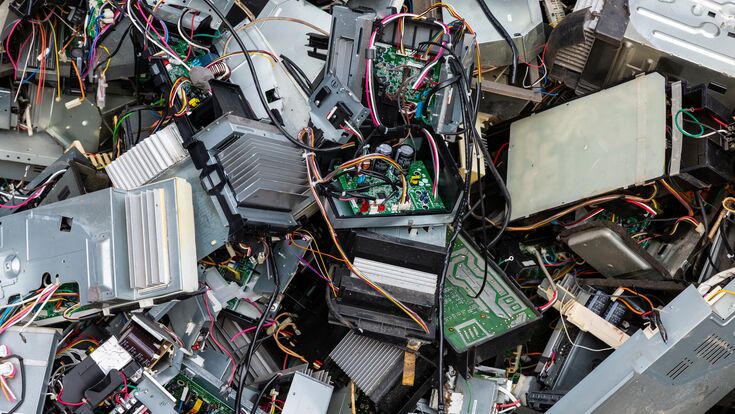The amount of discarded EEE is growing worldwide : The Global E-Waste Monitor 2024

EEE – electrical and electronic equipment is the pillar of our modern existence. Maybe it is also the bane of it. Our modern world would doubtlessly not function without it. We depend on our computers and phones and there is an ever-growing number of new appliances from e-bikes and e-scooters, health monitors and environmental sensors to furniture toys and even clothes with embedded electronics, electric tools, and energy-saving equipment such as LEDs, heat pumps and photovoltaics that seem to pop up regularly to make our lives more comfortable. But in the end, they go the way of all products: They end up as waste.
E-waste, basically any discarded product with a plug or battery, is the fastest-growing waste stream worldwide. Unfortunately, the global e-waste collection and recycling rate is not keeping pace with this growth.
The UN’s fourth Global E-waste Monitor (GEM) reveals staggering numbers: A record 62 million tonnes (Mt) of e-waste were produced in 2022, which means an increase of 82% from 2010. And it is estimated to rise another 32%, to 82 million tonnes, in 2030.
And just to better visualise the sheer volume: These 62 million tonnes of e-waste would fill 1.55 million 40-tonne trucks, roughly enough trucks to form a bumper-to-bumper line encircling the equator, according to the report UNITAR, the UN Institute for Training and Research and the International Telecommunication Union (ITU).
Related article: "The growing volume of e-waste is quickly overwhelming the current capacity to recycle it"
Recycling rate is lagging
While the documented formal collection and recycling rate has gone up as well, growing from 8 billion kg in 2010 at an average rate of 0.5 billion kg per year, it lags way behind the e-waste generation. The numbers mean, that the rise in e-waste generation is outpacing the rise in formal recycling by a factor of almost 5. This is not only an environmental and public health issue – according to the report 58 thousand kg of mercury and 45 million kg of plastics containing brominated flame retardants are released into the environment every year because of non-compliant e-waste management – but also a financial one. This waste stream does not only contain hazardous but also valuable materials. Nevertheless, less than one quarter (22.3%) of the e-waste generated in 2022 was documented as having been properly collected and recycled, leaving USD 62 billion worth of recoverable natural resources unaccounted for.
“No more than 1% of demand for essential rare earth elements is met by e-waste recycling. Simply put: Business as usual can’t continue. This new report represents an immediate call for greater investment in infrastructure development, more promotion of repair and reuse, capacity building, and measures to stop illegal e-waste shipments. And the investment would pay for itself in spades,” said Kees Baldé, lead author, UNITAR.
Related article: Global e-waste flows monitor 2022
The report also criticises that the world remains remarkably dependent on a handful of countries for rare earth elements, despite these materials' unique properties being essential for future technologies, such as renewable energy generation and e-mobility.
Valuable secondary raw materials recycled from e-waste include copper (worth $19 billion), gold ($15 billion), and iron ($16 billion). Existing e-waste management technologies can efficiently recover these metals at high rates, suggesting that improved collection rates could significantly increase value recovery. Currently, e-waste management yields $28 billion in secondary raw materials out of a potential $91 billion. Most of this is lost through incineration, landfill or inadequate treatment. The current production of secondary raw materials also prevents the extraction of 900 billion kilograms of ore.
Documented formal collection and recycling rates vary widely by region, with Europe leading the way at 42.8 per cent. However, EU Member States have made limited progress in meeting their legally binding collection targets. African countries generate the least e-waste but face significant challenges in recycling it, with rates below 1 per cent. Asia produces almost half of the world's e-waste (30 billion kg), but has made limited progress in managing e-waste, with relatively few countries having enacted legislation or set clear collection targets. In 2022, the regions generating the most e-waste per capita will be Europe (17.6 kg), Oceania (16.1 kg) and the Americas (14.1 kg). Despite having the most advanced collection and recycling infrastructure, these regions also had the highest documented collection and recycling rates per capita, with Europe at 7.53 kg, Oceania at 6.66 kg and the Americas at 4.2 kg per capita.
However, the report foresees a drop in the documented collection and recycling rate from 22.3% in 2022 to 20% by 2030 due to the widening difference in recycling efforts relative to the enormous growth of e-waste generation worldwide. The widening gap is driven by several factors, including advancements in technology, increased consumption, limited repair options, shorter product life spans, the growing electronification of society, design flaws, and insufficient e-waste management infrastructure. The report emphasizes that if countries could raise e-waste collection and recycling rates to 60% by 2030, the resulting benefits—such as reducing human health risks—would outweigh the costs, as co-author Ruediger Kuehr, Senior Manager, Sustainable Cycles (SCYCLE) Programme, UNITAR / Adjunct Professor, University of Limerick (Ireland) explained: “Improved e-waste management could result in a global net positive of USD 38 billion, representing a significant economic opportunity while addressing climate change and health impacts.”.
Illegal e-waste shipments
The report also highlights the issue of illegal cross-border shipments of e-waste. It notes that an increasing amount of electrical and electronic equipment (EEE) is being sold for the first time in developing countries. However, much of this equipment was first used in developed countries and shipped for further use due to lower prices.
In 2022, a total of 5.1 billion kilograms of e-waste was shipped across borders. Of this, an estimated 3.3 billion kilograms, or 65 per cent, was transported from high-income to middle- and low-income countries through uncontrolled and undocumented transboundary movements. A key challenge in regulating this flow is the difficulty in distinguishing between waste and used electrical and electronic equipment, which is not classified as waste. Illegal shipments exploit the fact that international trade codes do not distinguish between new and used equipment, leading to misclassification, misdeclaration and the mixing of legal used electrical and electronic equipment with illegal e-waste.
Related article: INTERPOL report: Nexus between organized crime and pollution crime
Due to increased enforcement and regional collaboration, there has been some progress in controlling illegal e-waste shipments in West Africa. However, in January 2023, an organised crime group was caught smuggling over 5 million kilograms (331 containers) of e-waste from the Canary Islands to Ghana, Mauritania, Nigeria and Senegal. In addition, in 2020, Spanish authorities intercepted a network that had shipped 2.5 billion kilograms of material to several African countries, including 750,000 kilograms of falsely certified e-waste. Despite ongoing efforts to monitor e-waste imports into Africa, effective control remains a major challenge.
Three of Africa’s busiest ports—Durban in South Africa, Bizerte in Tunisia, and Lagos in Nigeria—have been identified as significant entry points for used EEE, indicating that e-waste shipments continue to bypass the restrictions imposed by the Basel and Bamako Conventions. An Irish study, utilising the StEP Initiative's person-in-the-port methodology, revealed that roll-on/roll-off vehicles, rather than shipping containers, are the primary means of transporting used EEE from Ireland to West Africa. This study, conducted through the inspection of vehicles and enforcement documents at Ireland's Ringaskiddy port, extrapolated sampling data to estimate that approximately 17,319 kg of used EEE are exported from Ireland annually, with nearly 20% of exported vehicles containing such equipment. In light of these findings, West African nations are enhancing their oversight of used EEE and e-waste imports by rigorously enforcing existing regulations and performing comprehensive physical inspections of incoming shipments.
Related article: Waste companies take action to fight waste crime
E-waste by the numbers
- 62 million tonnes: e-waste generated in 2022, equivalent to the weight of 107,000 of the world's largest (853 seats) and heaviest (575 tonnes) passenger aircraft - enough to form an unbroken line from New York to Athens, Nairobi to Hanoi, or Hong Kong to Anchorage.
- 13.8 million tonnes (22.3%): estimated mass of e-waste to be disposed of, mostly in landfills, in 2022
- 31 million tonnes: estimated weight of metals embedded in e-waste in 2022, along with 17 million tonnes of plastics and 14 million tonnes of other materials (minerals, glass, composites, etc.)
- 91 billion US dollars: The value of metals embedded in e-waste in 2022, including $19 billion of copper, $15 billion of gold and $16 billion of iron.
- US $28 billion: Value of secondary raw materials (mostly iron) recovered through "urban mining" of e-waste in 2022.
- 900 million tonnes: Primary ore mining avoided by recovering materials through documented e-waste recycling
- 93 million tonnes: CO2-equivalent emissions avoided through formal e-waste management - recovered refrigerants (41 million tonnes), avoided metal mining (52 million tonnes)
Urgent action needed
The Global e-Waste Monitor concludes that urgent action is needed: “With less than half of the world implementing and enforcing approaches to manage the problem, this raises the alarm for sound regulations to boost collection and recycling. The Global E-waste Monitor is the world’s foremost source for e-waste data allowing us to track progress over time and to make critical decisions when it comes to transitioning to a circular economy for electronics”, said Cosmas Zavazava, Director, ITU Telecommunication Development Bureau. And UNITAR’s
Executive Director Nikhil Seth agreed: “Amidst the hopeful embrace of solar panels and electronic equipment to combat the climate crisis and drive digital progress, the surge in e-waste requires urgent attention.”
The report emphasises that a meaningful increase in e-waste collection and recycling will depend on significant collaboration between the formal and informal sectors, along with substantial enhancements and formalisation of the informal sector's operations.
About the Global E-Waste Monitor: When EEE is disposed of, it generates a waste stream that contains both hazardous and valuable materials, collectively known as e-waste, or waste electrical and electronic equipment (WEEE). The Global E-waste Monitor has been the foremost source of reporting on this pressing issue since 2014, providing the most up-to-date overview of global e-waste data, statistics, and progress in policy and regulation since 2014. It also provides a look at what the future holds if things change or stay the same.



